IceCube

Photo credit: Emanuel Jacobi, IceCube/NSF
For my PhD at Michigan State University, I’m working with MSU’s IceCube group under Dr. Tyce DeYoung.
IceCube is both a telescope and a detector. As a telescope, it uses elementary particles called neutrinos to see very high-energy happenings very far away. As a detector, it allows the collaboration to study the fundamental properties of neutrinos themselves.
My work with IceCube aims to look for signatures in IceCube data of neutrinos interacting with the Earth via particles that we’ve never seen before. For a more technical description, here’s an abstract for my contribution to the 2024 APS April meeting:
The IceCube Neutrino Observatory is a cubic-kilometer ice Cherenkov detector at the South Pole designed to detect neutrinos in the GeV to PeV energy range. Its in-ice PMT array includes DeepCore, a sub-detector specially instrumented for the detection of GeV-scale neutrinos. DeepCore detects neutrinos that originate in interactions of cosmic rays with the Earth’s atmosphere and travel long distances through the planet to interact in the South Pole’s glacial ice. These neutrinos forward scatter off charged fermions along their paths, which modifies their effective oscillation parameters. If a portion of these interactions are via particles outside of the Standard Model, the strength of such interactions can be probed by analyzing the impact of the interactions on the measurement of neutrino oscillations with DeepCore. An ongoing IceCube analysis aims to place competitive constraints on the strength of non-Standard neutrino interactions using 9.3 years of DeepCore data.
Laser-Induced Graphene Testing
As part of MSU’s TRAIN-MI high-energy physics detector instrumentation traineeship program, under Dr. Kendall Mahn I’m creating and testing the properties of laser-induced graphene (LIG) for potential use as a material for a field cage in a time projection chamber in space that would detect astrophysical gamma rays. Eventually we’ll collaborate with researchers at SLAC on this.
NOνA

Photo credit: Reidar Hahn, Fermilab Creative Services
As an undergrad at William & Mary, I worked with W&M’s NOνA group under Dr. Patricia Vahle.
NOνA is also a neutrino experiment, except instead of looking at neutrinos from space or Earth’s atmosphere, it produces its own neutrinos at an accelerator and shoots them through the Earth to a detector to study their fundamental properties.
My work helped with the calibration of the experiment’s far detector and test beam beamline instrumentation.
Learn more here.